Shirley Temple (1928-2014) was an American film and television actress, singer, dancer and public servant, but everybody knows her as the most famous child star in the 1930s. Shirley could do it all: act, sing and dance and all at the age of five! Four years in a row, between 1935 and 1938, she was the top box-office draw for Hollywood. As an adult, she entered politics and became a diplomat, serving as United States Ambassador to Ghana and later to Czechoslovakia, and as Chief of Protocol of the United States.

British Real Photograph postcard by Art Photo, no. 36.2. Photo: 20th Century Fox Film.
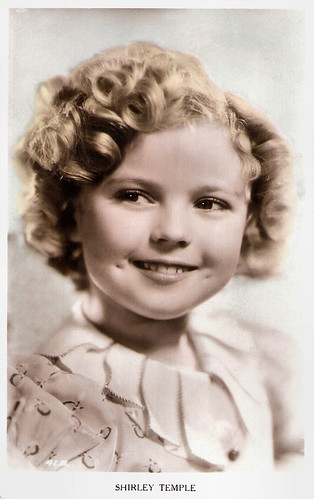
British Real Photograph postcard by Art Photo, no. 41B. Photo: 20th Century Fox Film.

British Real Photograph postcard, London, no. FS 52. Photo: 20th Century Fox Film. Shirley Temple, Michael Whalen and Claude Gillingwater in Poor Little Rich Girl (Irving Cummings, 1936).

British Real Photograph postcard, no. 64 D. Photo: Fox Films.

British Real Photograph postcard, London, no. 64.P. Photo: 20th Century Fox Film. Shirley Temple in Poor Little Rich Girl (Irving Cummings, 1936).

British Real Photograph postcard, London, no. FS 108. Photo: 20th Century Fox Film. Shirley Temple, Victor McLaglen and Douglas Scott in Wee Willie Winkie (John Ford, 1937).
Shirley Temple was born in 1928, in Santa Monica, California. She was the third child of homemaker Gertrude Amelia Temple and bank employee George Francis Temple. The family was of Dutch, English, and German ancestry. She had two brothers: John Stanley, and George Francis, Jr. The family moved to Brentwood, Los Angeles.
Her mother encouraged her singing, dancing, and acting talents, and in September 1931 enrolled her in Meglin's Dance School in Los Angeles. At about this time, Shirley's mother began styling her daughter's hair in ringlets.
While at the dance school, she was spotted by Charles Lamont, who was a casting director for Educational Pictures. Temple hid behind the piano while she was in the studio. Lamont took a liking to Temple, and invited her to audition; he signed her to a contract in 1932.
At the age of three, Shirley Temple began her film career in Baby Burlesks (Charles Lamont, 1932), multiple short films satirising recent film and political events by using preschool children in every role.
A series of two-reelers called Frolics of Youth followed with Temple playing Mary Lou Rogers, a youngster in a contemporary suburban family. To underwrite production costs at Educational Pictures, she and her child co-stars modelled for breakfast cereals and other products.
She was lent to Tower Productions for a small role in her first feature film, The Red-Haired Alibi (Christy Cabanne, 1932) and, in 1933, to Universal, Paramount, and Warner Bros. Pictures for various parts. After Educational Pictures declared bankruptcy in 1933, her father managed to purchase her contract for just $25.
Fox Film songwriter Jay Gorney arranged for her to have a screen test for the film Stand Up and Cheer! (Hamilton MacFadden, 1934). She won the part and was signed to a $150-per-week contract that was guaranteed for two weeks by Fox Film Corporation. The role was her breakthrough. Temple's charm was evident to Fox executives, and she was ushered into corporate offices almost immediately after finishing 'Baby Take a Bow', a song-and-dance number she did with James Dunn.
Her contract was extended to a year at the same $150/week with a seven-year option and her mother Gertrude was hired on at $25/week as her hairdresser and personal coach. In June 1934, her success continued when she was loaned out to Paramount for Little Miss Marker (Alexander Hall, 1934) with Adolphe Menjou, a story about a little girl held as collateral by gangsters.
Then, she found international fame in Bright Eyes (David Butler, 1934) with James Dunn, a feature film designed specifically for her talents. Her signature song, 'On the Good Ship Lollipop', was introduced in the film. In 1935, she received a special Juvenile Academy Award for her performance.
In 1935, Fox Films merged with Twentieth Century Pictures to become 20th Century Fox. Producer and studio head Darryl F. Zanuck focused his attention and resources upon cultivating Shirley's superstar status. She was said to be the studio's greatest asset. Nineteen writers, known as the Shirley Temple Story Development team, made 11 original stories and some adaptations of the classics for her. Film hits such as Curly Top (Irving Cummings, 1935), Poor Little Rich Girl (Irving Cummings, 1936) and Heidi (Allan Dwan, 1937) followed year after year during the mid-to-late 1930s.
Most of the Shirley Temple films were inexpensively made at $200,000 or $300,000 apiece and were comedy-dramas with songs and dances added, sentimental and melodramatic situations, and bearing little production value. Her film titles are a clue to the way she was marketed—Curly Top (Irving Cummings, 1935) and Dimples (Wiliam A. Seiter, 1936), and her 'little' pictures such as The Little Colonel (David Butler, 1935) with Lionel Barrymore, and The Littlest Rebel (David Butler, 1935). Shirley often played a fixer-upper, a precocious Cupid, or the good fairy in these films, reuniting her estranged parents or smoothing out the wrinkles in the romances of young couples.
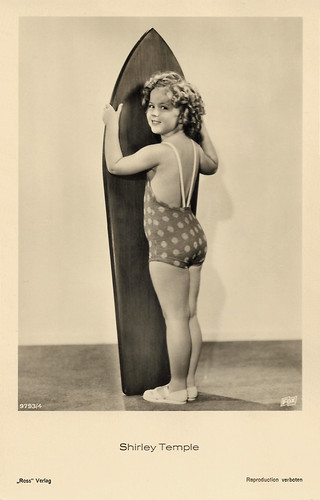
German postcard by Ross Verlag, no. 9793/4, 1935-1936. Photo: Fox.

German postcard by Ross Verlag, no. A 1080/1, 1937-1938. Photo: 20th Century Fox Film. Shirley Temple in Poor Little Rich Girl (Irving Cummings, 1936).

German postcard by Ross Verlag, no. A 1483/5, 1937-1938. Photo: 20th Century Fox Film. Shirley Temple in Heidi (Allan Dwan, 1937).

German postcard by Ross Verlag, no. A 1909/3, 1937-1938. Photo: 20th Century Fox. Shirley Temple and Bill Robinson in Just around the Corner (David Butler, 1938).
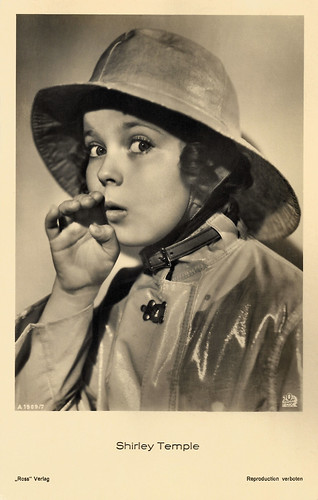
German postcard by Ross Verlag, no. A 1909/7, 1937-1938. Photo: 20th Century Fox. Shirley Temple in Captain January (David Butler, 1936).
Based on Shirley Temple's many screen successes, Darryl F. Zanuck increased budgets and production values for her films. By the end of 1935, her salary was $2,500 a week. Licensed merchandise that capitalised on her bright, bouncy and cheerful image included dolls, dishes, and clothing.
In 1937, John Ford was hired to direct the sepia-toned Wee Willie Winkie (Temple's own favourite) and an A-list cast was signed that included Victor McLaglen, C. Aubrey Smith and Cesar Romero. Elaborate sets were built at the famed Iverson Movie Ranch in Chatsworth, for the production, with a rock feature at the heavily filmed location ranch eventually being named the Shirley Temple Rock. The film was a critical and commercial hit.
In 1938, Rebecca of Sunnybrook Farm (Allan Dwan, 1938) with Randolph Scott, Little Miss Broadway (Irving Cummings, 1938) and Just around the Corner (David Butler, 1938) were released. The latter two were panned by the critics, and Just Around the Corner was the first of her films to show a slump in ticket sales.
The following year, Zanuck secured the rights to the children's novel 'A Little Princess', believing the book would be an ideal vehicle for the girl. He budgeted the film at $1.5 million - twice the amount of Just around the Corner (David Butler, 1938) - and chose it to be her first Technicolor feature. The Little Princess (Walter Lang, William A. Seiter, 1939) was a critical and commercial success, with Shirley's acting at its peak. Zanuck then cast her in Susannah of the Mounties (William A. Seiter, Walter Lang, 1939), her last money-maker for Twentieth Century Fox.
Her box office popularity waned as she reached adolescence. Her parents bought up the remainder of her contract, and sent her, at the age of 12, to Westlake School for Girls, an exclusive country day school in Los Angeles.
In 1944, David O. Selznick signed Shirley Temple to a four-year contract. She appeared in two wartime hits: Since You Went Away (John Cromwell, Edward F. Cline, 1944), and I'll Be Seeing You (William Dieterle, 1944). Selznick, however, became romantically involved with Jennifer Jones, and lost interest in developing Shirley's career. Temple was then lent to other studios. Kiss and Tell (Richard Wallace, 1945), The Bachelor and the Bobby-Soxer (Irving Reis, 1947) with Cary Grant, and Fort Apache (John Ford, 1948) with John Wayne and Henry Fonda, were her few good films at the time. Temple left the film industry in 1950 at the age of 22.
In 1958, Temple returned to show business with a two-season television anthology series of fairy tale adaptations, Shirley Temple's Storybook. She made guest appearances on television shows in the early 1960s and filmed a sitcom pilot that was never released. She sat on the boards of corporations and organisations including The Walt Disney Company, Del Monte Foods, and the National Wildlife Federation.
She began her diplomatic career in 1969, when she was appointed to represent the United States at a session of the United Nations General Assembly, where she worked at the U.S Mission under Ambassador Charles W. Yost. In 1988, she published her autobiography, 'Child Star'.
In 1943, 15-year-old Temple met John Agar, an Army Air Corps sergeant, physical training instructor, and member of a Chicago meat-packing family. She married him in 1945 before 500 guests. In 1948, Temple bore a daughter, Linda Susan. Agar became an actor, and the couple made two films together: Fort Apache (John Ford, 1948) and Adventure in Baltimore (1949). The marriage became troubled, and Temple divorced Agar on December in 1950. She was awarded custody of their daughter.
In January 1950, Temple met Charles Alden Black, a World War II Navy intelligence officer and Silver Star recipient and reputedly one of the richest young men in California. Temple and Black were married in his parents' Del Monte, California home in 1950. In 1952, Temple gave birth to a son, Charles Alden Black, Jr., and in 1954 to a daughter, Lori. The couple were married for 54 years until his death in 2005.
Shirley Temple Black was 85, when she died in 2014 in Woodside, California. Temple was the recipient of numerous awards and honours, including the Kennedy Center Honors and a Screen Actors Guild Life Achievement Award.
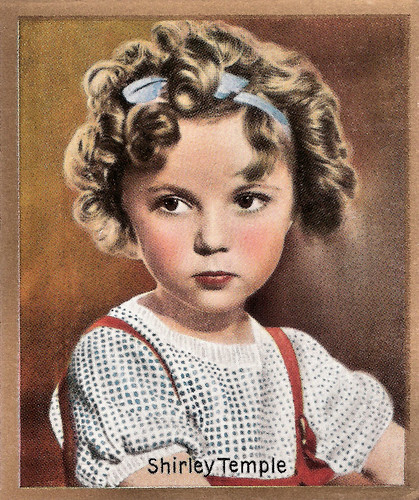
German collectors card in the Unsere Bunten Filmbilder series by Cigarettenfabrik Josetti, Berlin, no. 229. Photo: Fox / Ross Verlag.

German collectors card in the Bunte Filmbilder series by Caid, Series no. 2, no. 496. Photo: Fox-Film / Ross Verlag.

French postcard by Editions et Publications Cinématographiques, no. 107. Photo: Fox-Film.

British Real Photograph postcard, London, no. FS 181. Photo: 20th Century Fox. Shirley Temple and Bennie Bartlett in Just Around the Corner (Irving Cummings, 1938).
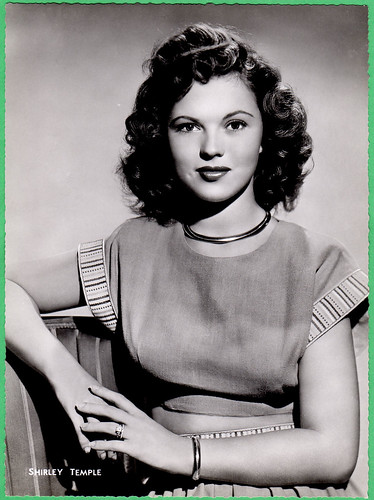
Belgian collectors card by Chocolaterie Clovis, Pepinster. Collection: Amit Benyovits.

Dutch postcard by J. Sleding N.V., Amsterdam, no. 31 HL. Photo: Nederland Film. Joseph Cotten and Shirley Temple in I'll Be Seeing You (William Dieterle, 1944).

Belgian postcard by N.V. Victoria, Brussels, no. 639 / 27. Photo: RKO Radio Films.
Sources: Wikipedia and IMDb.

British Real Photograph postcard by Art Photo, no. 36.2. Photo: 20th Century Fox Film.

British Real Photograph postcard by Art Photo, no. 41B. Photo: 20th Century Fox Film.

British Real Photograph postcard, London, no. FS 52. Photo: 20th Century Fox Film. Shirley Temple, Michael Whalen and Claude Gillingwater in Poor Little Rich Girl (Irving Cummings, 1936).

British Real Photograph postcard, no. 64 D. Photo: Fox Films.

British Real Photograph postcard, London, no. 64.P. Photo: 20th Century Fox Film. Shirley Temple in Poor Little Rich Girl (Irving Cummings, 1936).

British Real Photograph postcard, London, no. FS 108. Photo: 20th Century Fox Film. Shirley Temple, Victor McLaglen and Douglas Scott in Wee Willie Winkie (John Ford, 1937).
Baby Burlesks
Shirley Temple was born in 1928, in Santa Monica, California. She was the third child of homemaker Gertrude Amelia Temple and bank employee George Francis Temple. The family was of Dutch, English, and German ancestry. She had two brothers: John Stanley, and George Francis, Jr. The family moved to Brentwood, Los Angeles.
Her mother encouraged her singing, dancing, and acting talents, and in September 1931 enrolled her in Meglin's Dance School in Los Angeles. At about this time, Shirley's mother began styling her daughter's hair in ringlets.
While at the dance school, she was spotted by Charles Lamont, who was a casting director for Educational Pictures. Temple hid behind the piano while she was in the studio. Lamont took a liking to Temple, and invited her to audition; he signed her to a contract in 1932.
At the age of three, Shirley Temple began her film career in Baby Burlesks (Charles Lamont, 1932), multiple short films satirising recent film and political events by using preschool children in every role.
A series of two-reelers called Frolics of Youth followed with Temple playing Mary Lou Rogers, a youngster in a contemporary suburban family. To underwrite production costs at Educational Pictures, she and her child co-stars modelled for breakfast cereals and other products.
She was lent to Tower Productions for a small role in her first feature film, The Red-Haired Alibi (Christy Cabanne, 1932) and, in 1933, to Universal, Paramount, and Warner Bros. Pictures for various parts. After Educational Pictures declared bankruptcy in 1933, her father managed to purchase her contract for just $25.
Fox Film songwriter Jay Gorney arranged for her to have a screen test for the film Stand Up and Cheer! (Hamilton MacFadden, 1934). She won the part and was signed to a $150-per-week contract that was guaranteed for two weeks by Fox Film Corporation. The role was her breakthrough. Temple's charm was evident to Fox executives, and she was ushered into corporate offices almost immediately after finishing 'Baby Take a Bow', a song-and-dance number she did with James Dunn.
Her contract was extended to a year at the same $150/week with a seven-year option and her mother Gertrude was hired on at $25/week as her hairdresser and personal coach. In June 1934, her success continued when she was loaned out to Paramount for Little Miss Marker (Alexander Hall, 1934) with Adolphe Menjou, a story about a little girl held as collateral by gangsters.
Then, she found international fame in Bright Eyes (David Butler, 1934) with James Dunn, a feature film designed specifically for her talents. Her signature song, 'On the Good Ship Lollipop', was introduced in the film. In 1935, she received a special Juvenile Academy Award for her performance.
In 1935, Fox Films merged with Twentieth Century Pictures to become 20th Century Fox. Producer and studio head Darryl F. Zanuck focused his attention and resources upon cultivating Shirley's superstar status. She was said to be the studio's greatest asset. Nineteen writers, known as the Shirley Temple Story Development team, made 11 original stories and some adaptations of the classics for her. Film hits such as Curly Top (Irving Cummings, 1935), Poor Little Rich Girl (Irving Cummings, 1936) and Heidi (Allan Dwan, 1937) followed year after year during the mid-to-late 1930s.
Most of the Shirley Temple films were inexpensively made at $200,000 or $300,000 apiece and were comedy-dramas with songs and dances added, sentimental and melodramatic situations, and bearing little production value. Her film titles are a clue to the way she was marketed—Curly Top (Irving Cummings, 1935) and Dimples (Wiliam A. Seiter, 1936), and her 'little' pictures such as The Little Colonel (David Butler, 1935) with Lionel Barrymore, and The Littlest Rebel (David Butler, 1935). Shirley often played a fixer-upper, a precocious Cupid, or the good fairy in these films, reuniting her estranged parents or smoothing out the wrinkles in the romances of young couples.

German postcard by Ross Verlag, no. 9793/4, 1935-1936. Photo: Fox.

German postcard by Ross Verlag, no. A 1080/1, 1937-1938. Photo: 20th Century Fox Film. Shirley Temple in Poor Little Rich Girl (Irving Cummings, 1936).

German postcard by Ross Verlag, no. A 1483/5, 1937-1938. Photo: 20th Century Fox Film. Shirley Temple in Heidi (Allan Dwan, 1937).

German postcard by Ross Verlag, no. A 1909/3, 1937-1938. Photo: 20th Century Fox. Shirley Temple and Bill Robinson in Just around the Corner (David Butler, 1938).

German postcard by Ross Verlag, no. A 1909/7, 1937-1938. Photo: 20th Century Fox. Shirley Temple in Captain January (David Butler, 1936).
Bright, bouncy and cheerful image
Based on Shirley Temple's many screen successes, Darryl F. Zanuck increased budgets and production values for her films. By the end of 1935, her salary was $2,500 a week. Licensed merchandise that capitalised on her bright, bouncy and cheerful image included dolls, dishes, and clothing.
In 1937, John Ford was hired to direct the sepia-toned Wee Willie Winkie (Temple's own favourite) and an A-list cast was signed that included Victor McLaglen, C. Aubrey Smith and Cesar Romero. Elaborate sets were built at the famed Iverson Movie Ranch in Chatsworth, for the production, with a rock feature at the heavily filmed location ranch eventually being named the Shirley Temple Rock. The film was a critical and commercial hit.
In 1938, Rebecca of Sunnybrook Farm (Allan Dwan, 1938) with Randolph Scott, Little Miss Broadway (Irving Cummings, 1938) and Just around the Corner (David Butler, 1938) were released. The latter two were panned by the critics, and Just Around the Corner was the first of her films to show a slump in ticket sales.
The following year, Zanuck secured the rights to the children's novel 'A Little Princess', believing the book would be an ideal vehicle for the girl. He budgeted the film at $1.5 million - twice the amount of Just around the Corner (David Butler, 1938) - and chose it to be her first Technicolor feature. The Little Princess (Walter Lang, William A. Seiter, 1939) was a critical and commercial success, with Shirley's acting at its peak. Zanuck then cast her in Susannah of the Mounties (William A. Seiter, Walter Lang, 1939), her last money-maker for Twentieth Century Fox.
Her box office popularity waned as she reached adolescence. Her parents bought up the remainder of her contract, and sent her, at the age of 12, to Westlake School for Girls, an exclusive country day school in Los Angeles.
In 1944, David O. Selznick signed Shirley Temple to a four-year contract. She appeared in two wartime hits: Since You Went Away (John Cromwell, Edward F. Cline, 1944), and I'll Be Seeing You (William Dieterle, 1944). Selznick, however, became romantically involved with Jennifer Jones, and lost interest in developing Shirley's career. Temple was then lent to other studios. Kiss and Tell (Richard Wallace, 1945), The Bachelor and the Bobby-Soxer (Irving Reis, 1947) with Cary Grant, and Fort Apache (John Ford, 1948) with John Wayne and Henry Fonda, were her few good films at the time. Temple left the film industry in 1950 at the age of 22.
In 1958, Temple returned to show business with a two-season television anthology series of fairy tale adaptations, Shirley Temple's Storybook. She made guest appearances on television shows in the early 1960s and filmed a sitcom pilot that was never released. She sat on the boards of corporations and organisations including The Walt Disney Company, Del Monte Foods, and the National Wildlife Federation.
She began her diplomatic career in 1969, when she was appointed to represent the United States at a session of the United Nations General Assembly, where she worked at the U.S Mission under Ambassador Charles W. Yost. In 1988, she published her autobiography, 'Child Star'.
In 1943, 15-year-old Temple met John Agar, an Army Air Corps sergeant, physical training instructor, and member of a Chicago meat-packing family. She married him in 1945 before 500 guests. In 1948, Temple bore a daughter, Linda Susan. Agar became an actor, and the couple made two films together: Fort Apache (John Ford, 1948) and Adventure in Baltimore (1949). The marriage became troubled, and Temple divorced Agar on December in 1950. She was awarded custody of their daughter.
In January 1950, Temple met Charles Alden Black, a World War II Navy intelligence officer and Silver Star recipient and reputedly one of the richest young men in California. Temple and Black were married in his parents' Del Monte, California home in 1950. In 1952, Temple gave birth to a son, Charles Alden Black, Jr., and in 1954 to a daughter, Lori. The couple were married for 54 years until his death in 2005.
Shirley Temple Black was 85, when she died in 2014 in Woodside, California. Temple was the recipient of numerous awards and honours, including the Kennedy Center Honors and a Screen Actors Guild Life Achievement Award.

German collectors card in the Unsere Bunten Filmbilder series by Cigarettenfabrik Josetti, Berlin, no. 229. Photo: Fox / Ross Verlag.

German collectors card in the Bunte Filmbilder series by Caid, Series no. 2, no. 496. Photo: Fox-Film / Ross Verlag.

French postcard by Editions et Publications Cinématographiques, no. 107. Photo: Fox-Film.

British Real Photograph postcard, London, no. FS 181. Photo: 20th Century Fox. Shirley Temple and Bennie Bartlett in Just Around the Corner (Irving Cummings, 1938).

Belgian collectors card by Chocolaterie Clovis, Pepinster. Collection: Amit Benyovits.

Dutch postcard by J. Sleding N.V., Amsterdam, no. 31 HL. Photo: Nederland Film. Joseph Cotten and Shirley Temple in I'll Be Seeing You (William Dieterle, 1944).

Belgian postcard by N.V. Victoria, Brussels, no. 639 / 27. Photo: RKO Radio Films.
Sources: Wikipedia and IMDb.
No comments:
Post a Comment